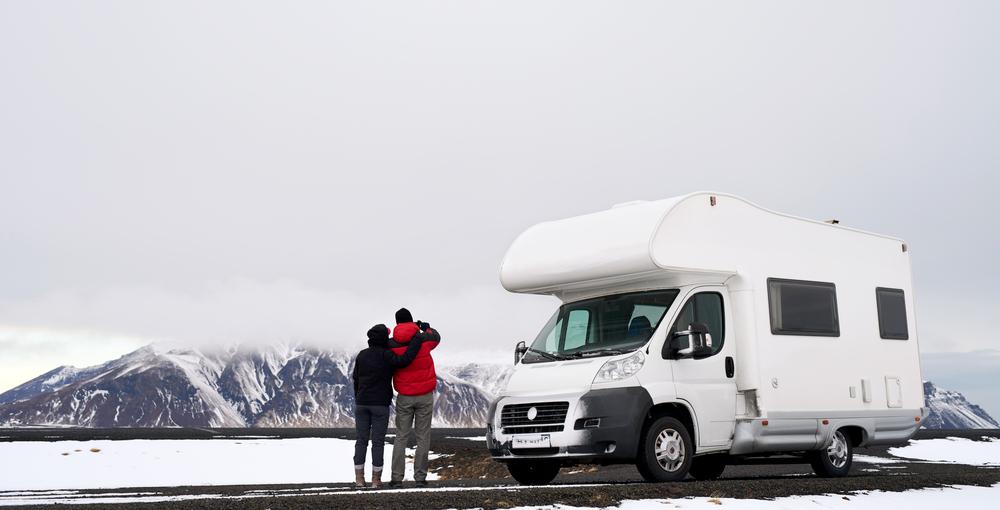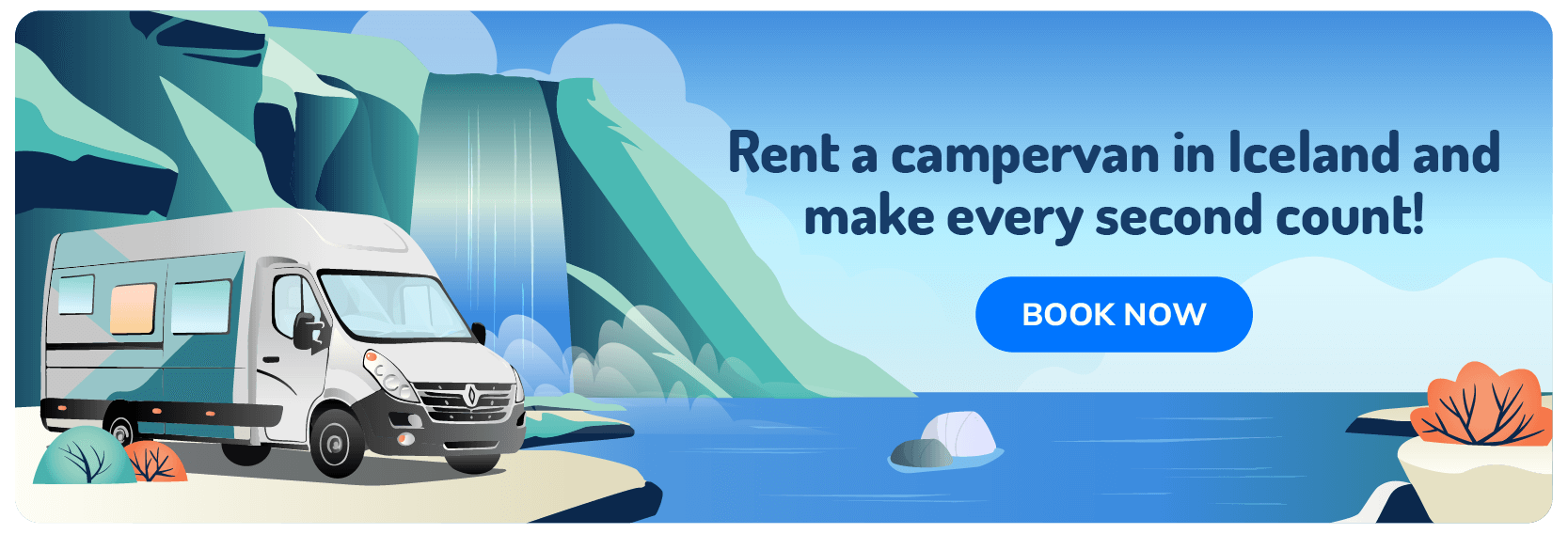Whether it’s just household lingo or different countries, we all seem to have very different takes on what we refer to as an RV or a camper. So, is there really a difference between an RV and a camper? And if so, what is it?
This article aims to demystify the jargon and help you understand what will best suit your journey, as well as what to expect from an RV or camper adventure in Iceland. So, without further ado, let’s get into some linguistic semantics.
Camper vs. RV: What These Terms Mean in Iceland
Even Googling the words will leave you a little confused, as the results will show up as a mixed bag of campers and motorhomes of various shapes and sizes. The primary reason for this mix-up is the differing definitions of these terms between countries.
For example, in the US, an RV is a term used broadly to describe everything from a massive motorhome to a compact little camper van, whereas in Europe and Iceland, there is a significant difference between these categories.
An RV is also referred to as a motorhome here and is essentially a massive home on wheels (think rock star tour bus or the motorhomes seen in movies such as RV, starring the late, great Robin Williams). These usually have all the amenities you could possibly think of (bathroom, kitchen, etc.), as if you’ve never even left the house.
A camper, on the other hand, is a small to medium-sized van. These guys have usually been converted to offer a sleeping area and a small kitchenette, but you won’t be spending your holiday indoors in them. They are designed with a focus on traveling and exploring, as well as offering affordable accommodations (aka camping in comfort).
It’s essential to understand the differences in meanings, as they will impact where you can go and your overall trip experience. For example, if you’re a family of five wanting to explore the more remote regions of the island, a camper is definitely going to be a no-go.
Similarly, a couple wanting to explore the Highlands in a massive motorhome will barely begin their adventure before getting stuck on our rougher and narrower mountain roads. Booking the right fit for you and your planned itinerary is essential for a successful trip.
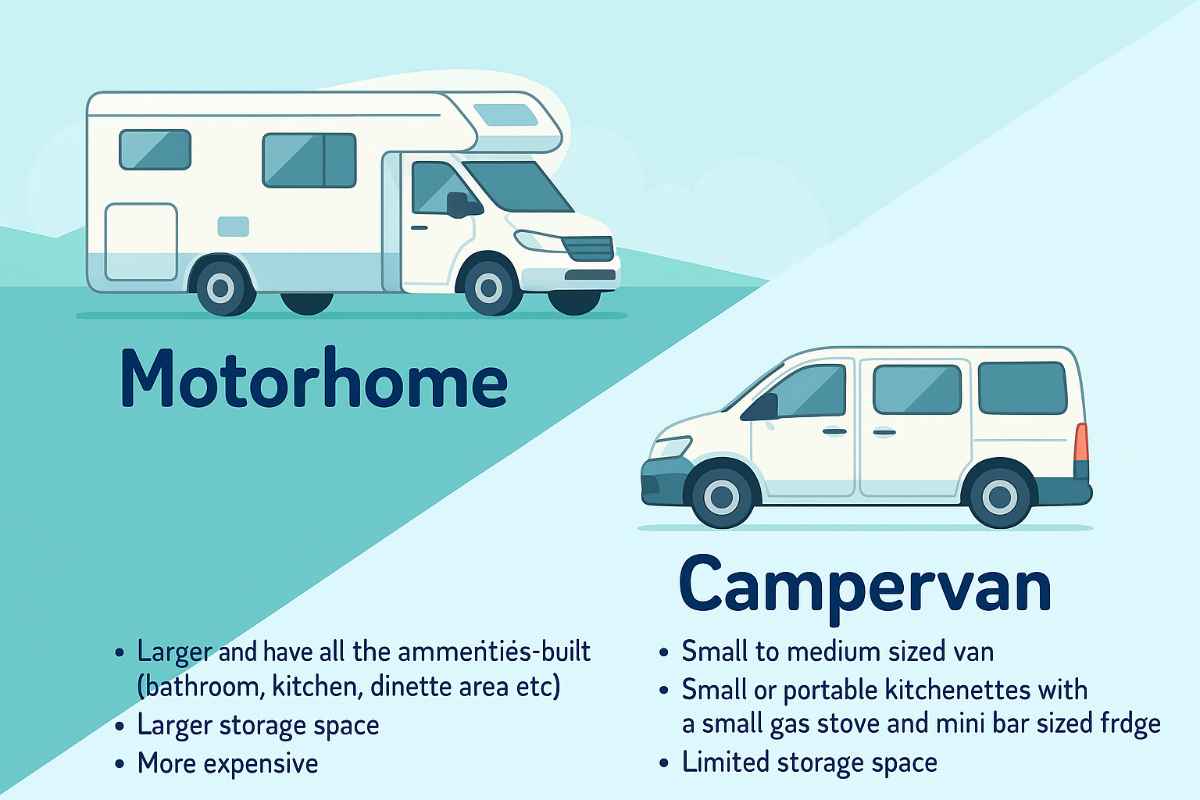
What’s a Camper in Iceland?
The following will help you define what to expect from a campervan in Iceland even further:
Features of Icelandic Campervans
The focus of Icelandic campers is on practicality and bringing you the ultimate adventure experience. While compact, the space is dedicated to functionality and has been maximized to avoid feeling cramped.
This is why you’ll find plenty of space-saving furniture, such as seats that convert into beds or beds that convert into tables, and so forth. A camper is also made to fit between 2 and 4 people. Although campers usually have kitchens, they tend to be in the form of small kitchenettes with a sink, a small gas stove, and a mini-bar-sized fridge.
As you can imagine, storage space is limited, so this is not the time to pack for any “what-if” occasions. Most campers in Iceland do not have bathrooms, so you’ll need to rely on the communal facilities at campsites and other attractions around the country.
Driving a camper is not difficult, and except for a bit more special awareness, it will feel just like driving a regular car. Iceland offers visitors both 2-wheel drive and 4x4 campervan options. The choice will depend on your planned route and itinerary.
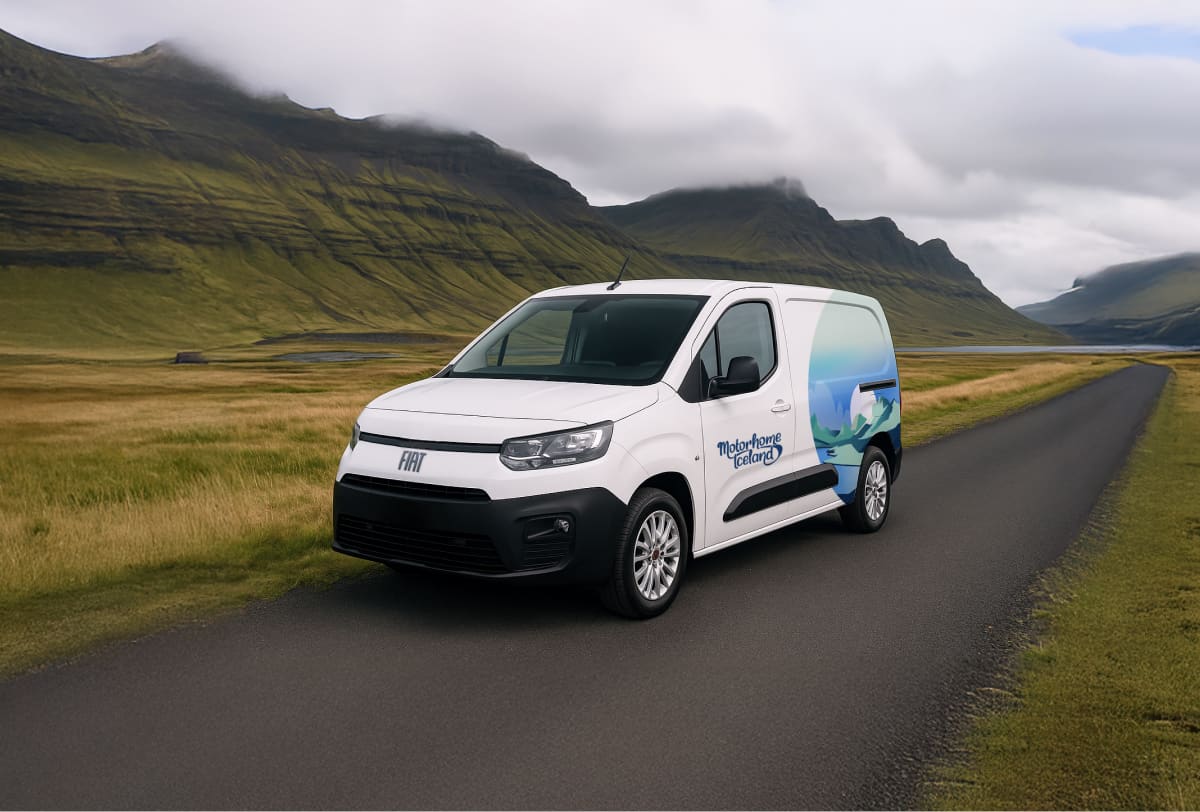
The Advantages of Campervans for Iceland Road Trips
Campervans offer numerous advantages for road tripping around the island. These include:
- Flexibility – You don’t need to be hounded by someone else’s strict itinerary or pre-booked accommodation with strict check-in times. A camper allows you to be the captain of your own adventure, and you can pretty much just pitch up at a campsite anytime you want, without pre-booking (as long as it’s not during our busiest peak season periods).
- Accessibility – A compact camper is the ideal transport method to navigate our often narrow and winding roads, as well as zip in and out of parking spots in town. You’ll also be able to tackle any road conditions, as long as you opt for a 4x4 model.
- Affordability – For one price, you take care of both your transport and accommodation needs. Just overnight at our many incredible and super affordable camping sites and get yourself the Camping Card to save even more on your holiday budget. Of course, the smaller the camper, the less fuel it will use, giving you even more bang for your buck.
Campervan Limitations to Consider
Of course, as with most things in life, pros always come with a few cons, and you’ll need to decide whether you’ll manage with the limitations of a camper. These include the following:
- Most campers don’t have bathroom facilities, so you’ll need to rely on public restrooms or communal bathrooms and showers at campsites.
- Space is restricted, so traveling in larger groups or with smaller children can really test your resolve, especially on rainy days. And if you’re someone who usually packs three different “possible” outfits for each day, you’re also going to struggle with the storage space available to you.
- Exploring the island during the winter months can be challenging for several reasons. The weather is extremely harsh, so if you’re someone who already struggles with the cold, it’s going to become extremely uncomfortable for you. Due to the weather conditions and annual road closures, navigating the roads and thoroughly exploring the island can be challenging.
- If you’re someone who enjoys creature comforts that go beyond basic needs and requirements (we mean, the blow-dryer in the hotel drawer and room service kind), you may find a camper adventure lacking in certain luxuries.
- If you have never done a campervan road trip before, we highly recommend sticking to a beginner one to two weeks. Some find (unexpectedly) that longer and extended trips can trigger some cabin fever feelings, and they may realize that they can’t share personal space with others for so long before needing to go into their “cave” and recharge (and yes, even from your partner or spouse).
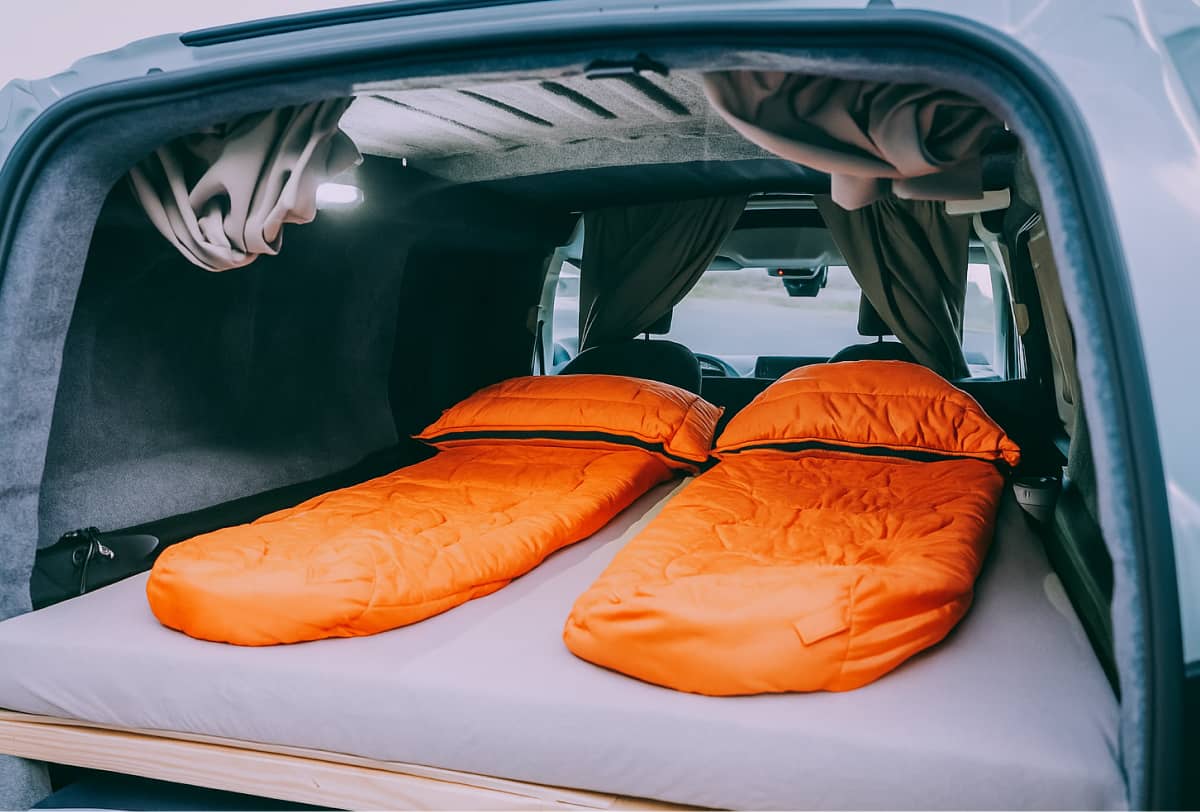
What is a Motorhome or RV?
The following will help you define what to expect from a motorhome in Iceland even further:
Features of Icelandic Motorhomes
Motorhomes, also known as RVs here in Iceland, are homes on wheels. These giants of the road are built with comfort in mind, and exploring the “road less traveled” is left on the back burner in exchange for creature comforts.
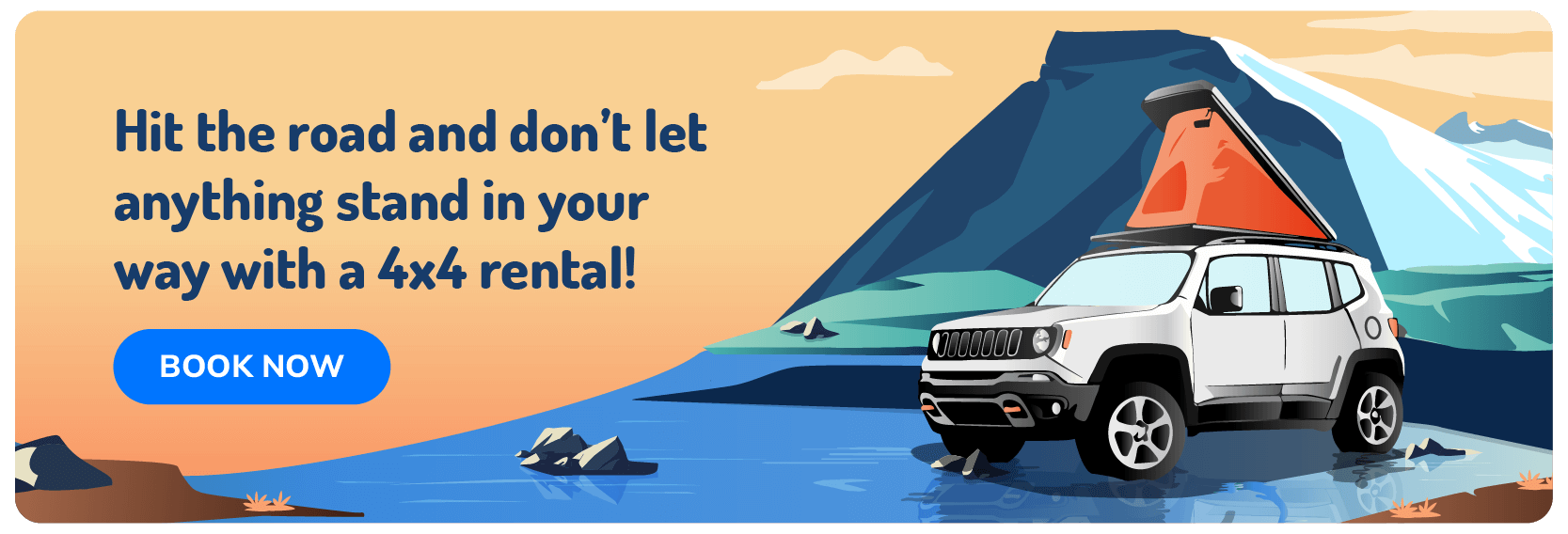
They can have multiple and completely separate sleeping areas that often need no space-saving conversion methods. You’ll also find full kitchens and bathroom facilities on board. Living spaces are also much larger. Motorhomes in Iceland can accommodate between 2 and 6 people at a time, making them the ideal mode of transportation for larger groups of friends or families.
The fact that a motorhome is much more spacious with these separate living and sleeping areas makes them much more conducive to longer trips (without anyone irritation murdering each other along the way).
The Advantages of Motorhomes for Iceland Road Trips
Motorhomes have plenty of advantages when it comes to road tripping around the island. These include:
- Ultimate convenience – There’s no need to rely on public facilities and amenities since you already have it all. This becomes especially convenient on those early mornings, late nights, and bad weather days.
- Ultimate comfort – With all that extra space and little luxury touches, gadgets, and gizmos, it's easy to enjoy spending time indoors. So, as long as you stick to the main roads, which are paved, well-maintained, and relatively wide, you’ll have the time of your life, whether exploring the outdoors or just chilling inside the motorhome.
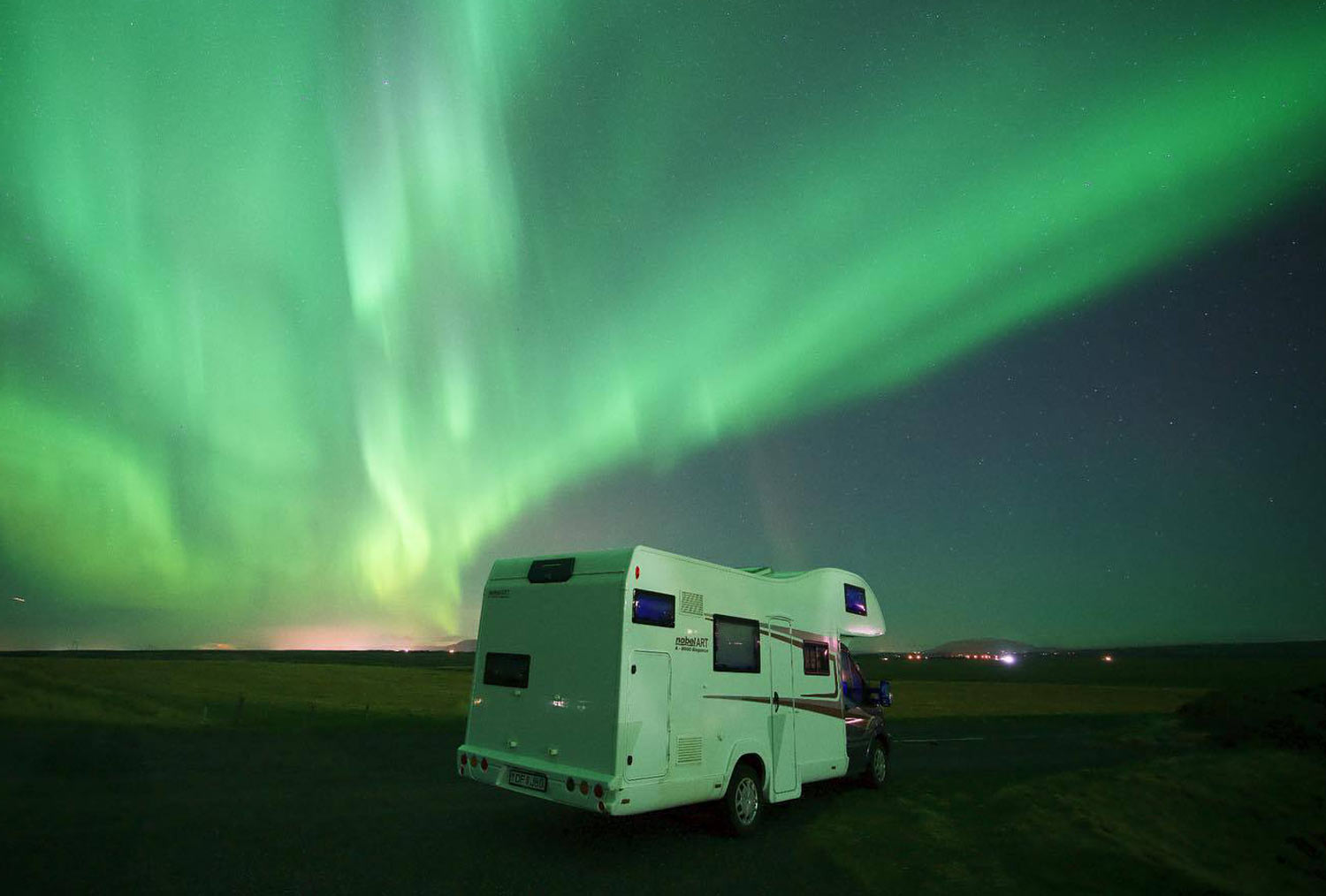
Motorhome Limitations to Consider
The following are some of the drawbacks of a motorhome that’ll play a role in whether it makes for suitable transport for your upcoming trip to Iceland:
- Motorhomes are massive (how else will you squeeze in all those creature comforts?), so they can be challenging to drive. In fact, some will require a different driver’s license code that enables you to drive larger trucks.
- Due to their size, they’re also incredibly tricky to navigate. You'd better be ready not to find parking spots in our little towns or not being able to see some of our beautiful sights, since you simply won’t fit or manage on the roads to get there.
- As with campervans, winter presents numerous challenges for driving and staying inside a motorhome, including temperature control, finding suitable campsites, and navigating less-than-ideal road conditions.
- Motorhomes require more attention, and with everything being larger, everything takes significantly more effort and time, such as setting up and waste disposal.
- A motorhome is definitely not a budget-friendly option. Its rental and added extras cost more, require more electricity, and will gobble up gas.
Key Differences Between Campers and RVs in Iceland
Here we discuss the biggest differences to help you decide whether an RV or camper will work best for you.
Size and Maneuverability
Motorhomes are huge, challenging to maneuver, and simply won’t be able to park or drive in certain places. Campers, on the other hand, can easily navigate our smaller towns and narrower roads, and it’s easy to find parking spots.
4x4 Access and F-road Compatibility
Taking on 4x4 routes in Iceland with a motorhome is not recommended. This is due to their size and weight, which makes maneuvering on these roads nearly impossible. Even with a 4x4 motorhome, you’ll also still not be allowed on the F-roads here in Iceland.
However, with 4x4 capabilities, a 4x4 camper will allow you to traverse those rough and tough roads that lead you to some of our breathtaking hidden gems and regions, including the F-roads in the Highlands of Iceland.
Comfort and Living Space
Campervans offer basic amenities and facilities, with their primary function being practicality and getting you from point A to point B in a unique and budget-friendly way. Motorhomes, on the other hand, are built with comfort in mind.
With all the amenities and facilities you could possibly need and plenty of space, the indoor experience is just as much a part of the journey as the outdoor experiences. Needless to say, this makes motorhomes a much better option for larger families or groups of friends and those wanting to go on longer and extended trips.
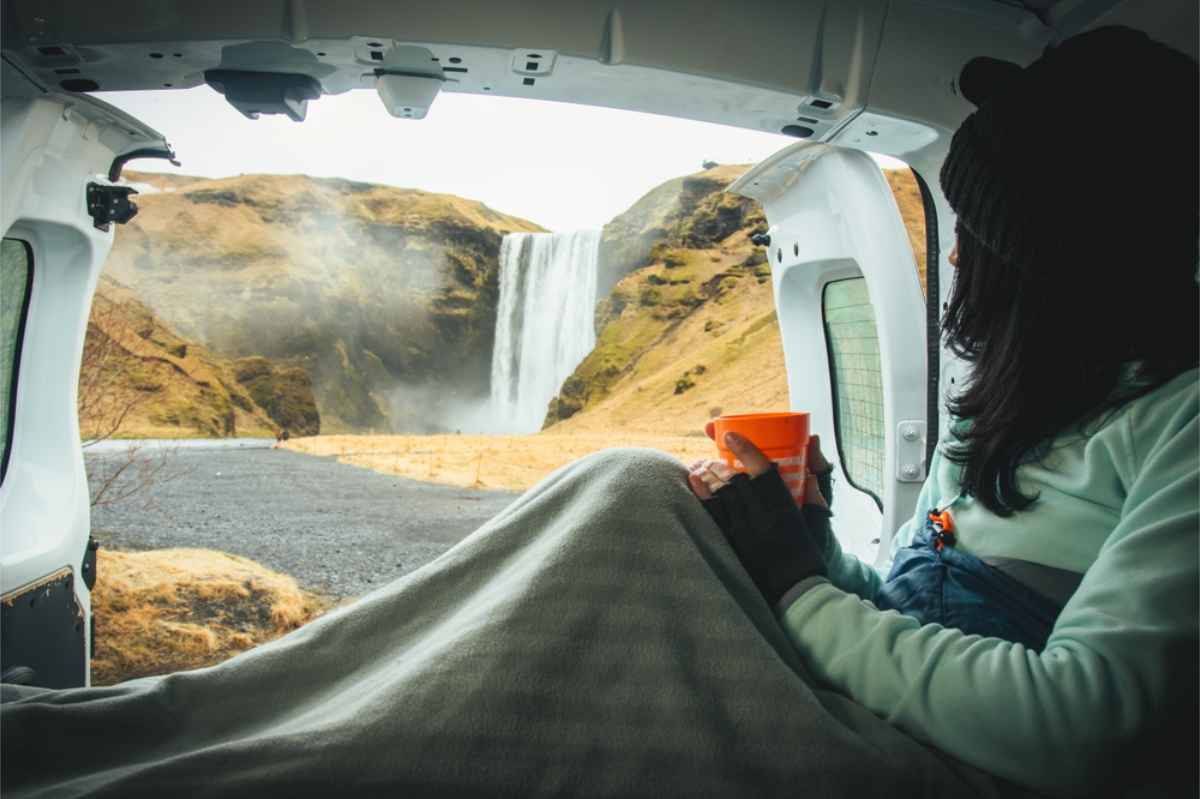
Parking and Campsite Restrictions
We already mentioned that finding parking with a motorhome can be challenging. While popular spots might call for a bit of creative parking, the joy of having your home on wheels is unmatched.
Some campsites are designed to cater to a variety of campers, meaning a few are only optimized for smaller setups. Large motorhomes take up so much space that they’ll inevitably take the space from other traditional campers and those in compact campers. This also means that a lot more planning will be required for a motorhome road trip than for a road trip in a camper.
Winter Travel Considerations
We’ve already mentioned that road-tripping around the island can be challenging, whether doing so in a motorhome or a campervan. However, with the right gear, equipment, and attitude, it’s still possible to road trip around Iceland in a campervan, although we definitely wouldn’t recommend attempting this in a motorhome. You’re bound to get stuck somewhere.
Cost Comparison: What’s the Difference Between a Camper and an RV Rental in Iceland?
Perhaps you may have already guessed which of these two is the most budget-friendly option, but here’s what to consider when deciding which will suit your budget best:
Rental Rates
Needless to say, the larger motorhomes will always take a larger chunk out of your holiday budget than a campervan, but the impact on your pocket can feel exceptionally hard during our peak season, with its peak-season prices. During the off-season, when campervans are still an option, you’ll also find that many rental agencies offer them at discounted rates.
Fuel Consumption
Campervans are generally more fuel-efficient than motorhomes, as they’re smaller and require less engine work to maintain.
Additional Costs
Motorhomes also incur additional costs, including electricity, waste disposal, and refilling water tanks, among others. The greater risk associated with a motorhome also makes insurance more expensive.
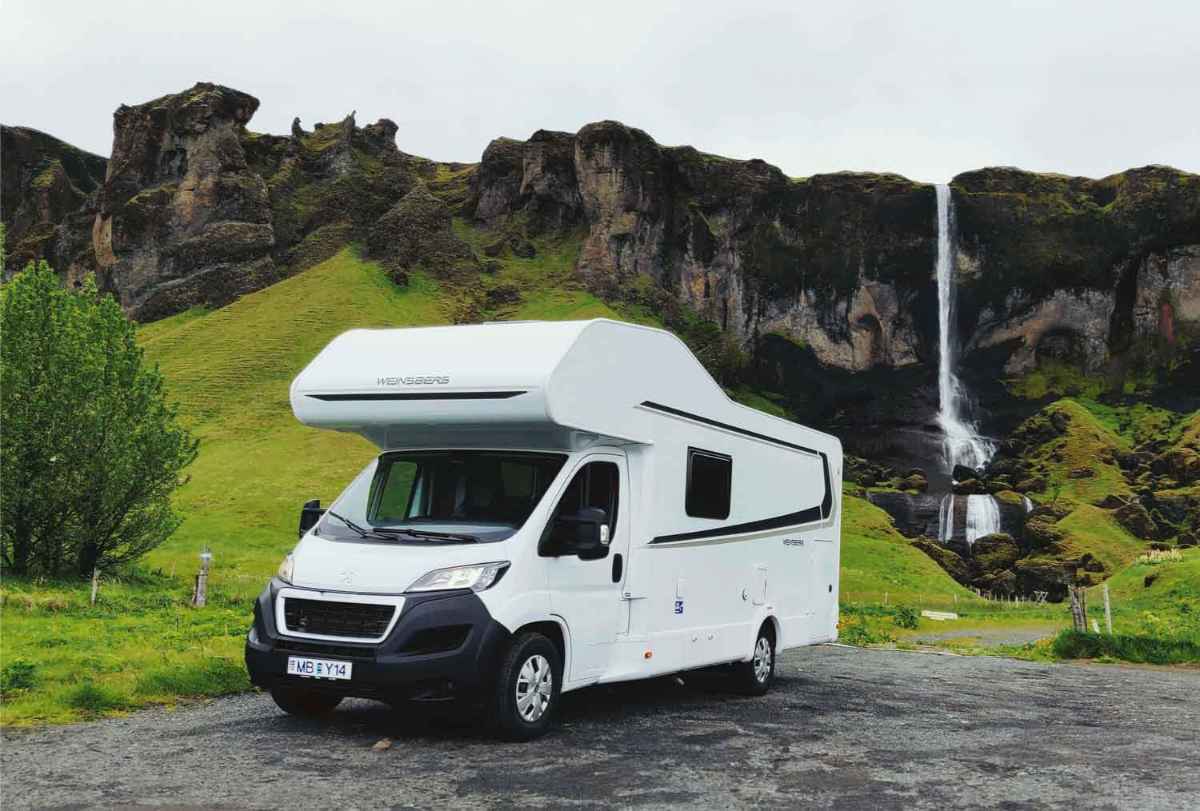
Which Should You Choose for Your Iceland Trip?
As you can see, there are many factors to consider when deciding whether to go with a camper or an RV. However, the following should help you narrow it down based on your planned itinerary:
When Going on a Ring Road Road Trip
The Ring Road is a loop road that runs all around the island. It’s not only one of our main roads but also an important logistical artery for transporting goods and services across the country.
This is why the road is paved and well-maintained throughout the year, making it a great option for travel even during the winter season (just be cautious in the north, where the weather can be much harsher than in the rest of the country). This road is easily accessible with both a campervan and a motorhome and doesn’t require 4-wheel drive either.
When Going on a Golden Circle Road Trip
The Golden Circle is also a loop road, but it’s much smaller than the Ring Road, making it ideal for those on a tight budget or with limited time on the island. The Golden Circle primarily explores the southwest of Iceland, encompassing many of our most famous activities and attractions.
This is another main road that is paved and well-maintained, making it a great option for all year round for both campers and motorhomes (two-wheel drive will suffice), although the winter season will require some additional gear and accessories, such as winter tires.
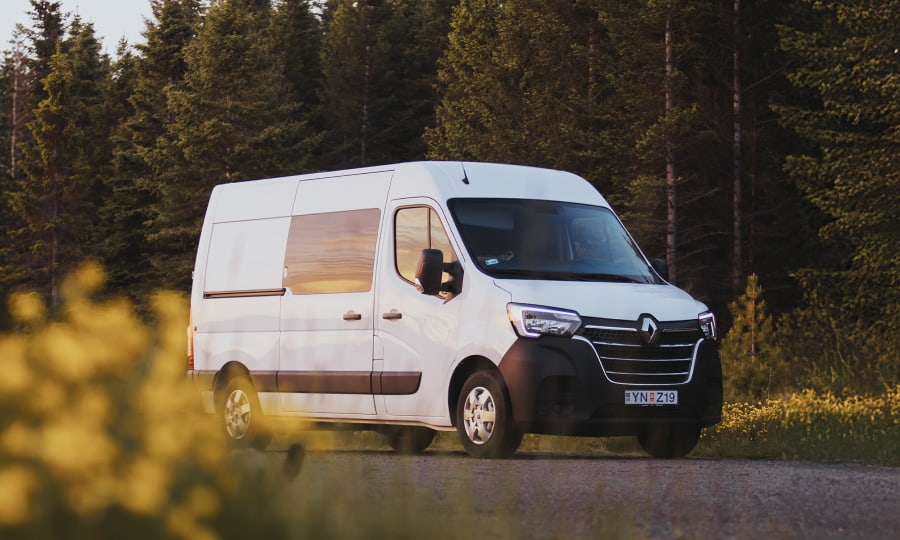
When Going on a Highlands Road Trip
Most of the roads allowing you to explore the Highlands are F-roads. These are our rough-and-tough roads with all sorts of obstacles, including river crossings. You are legally not allowed to drive the F-roads without a 4x4 vehicle, and due to the roads being impassable during colder weather, they are only open during Iceland’s summer months.
Therefore, you will only be able to plan a road trip through the Highlands if you’re planning on visiting during the summertime, and you’ll only be able to take this road trip in a 4x4 campervan.
A Comparison Table: Campervan vs. RV in Iceland
Below you’ll find a quick-reference comparison table to help you decide on whether to go with a campervan or an RV on your upcoming trip to Iceland:
|
Feature |
Campervan |
Motorhome/RV |
|
Size |
Small/Medium |
Large |
|
Sleeps |
2 to 4 |
2 to 6 |
|
Bathroom |
Mostly No |
Yes |
|
Kitchen |
Basic (like a kitchenette) |
Full |
|
Parking |
Easy |
Difficult |
|
F-Road Access |
Yes (with 4x4) |
No |
|
Winter Travel |
Possible (with preparation) |
Not recommended |
|
Rental Cost |
Lower |
Higher |
|
Flexibility |
High |
Low |
|
Comfort |
Basic |
High |
Final Thoughts: Flexibility or Comfort?
Whether you ultimately choose an RV or a campervan will depend on your personal preferences, your planned trip itinerary, and your holiday budget. Both have their own unique pros and cons. Just make sure to choose (and book!) the right vehicle for your trip, as it can really make or break your Iceland adventure.
Looking for the most affordable option? Then, a campervan might be the perfect choice for you. Looking for the ultimate convenience and comfort? Then, renting a motorhome in Iceland should be your top priority. So, make your choice, plan that trip, and hit the road for your once-in-a-lifetime journey here in the Land of Fire and Ice!
